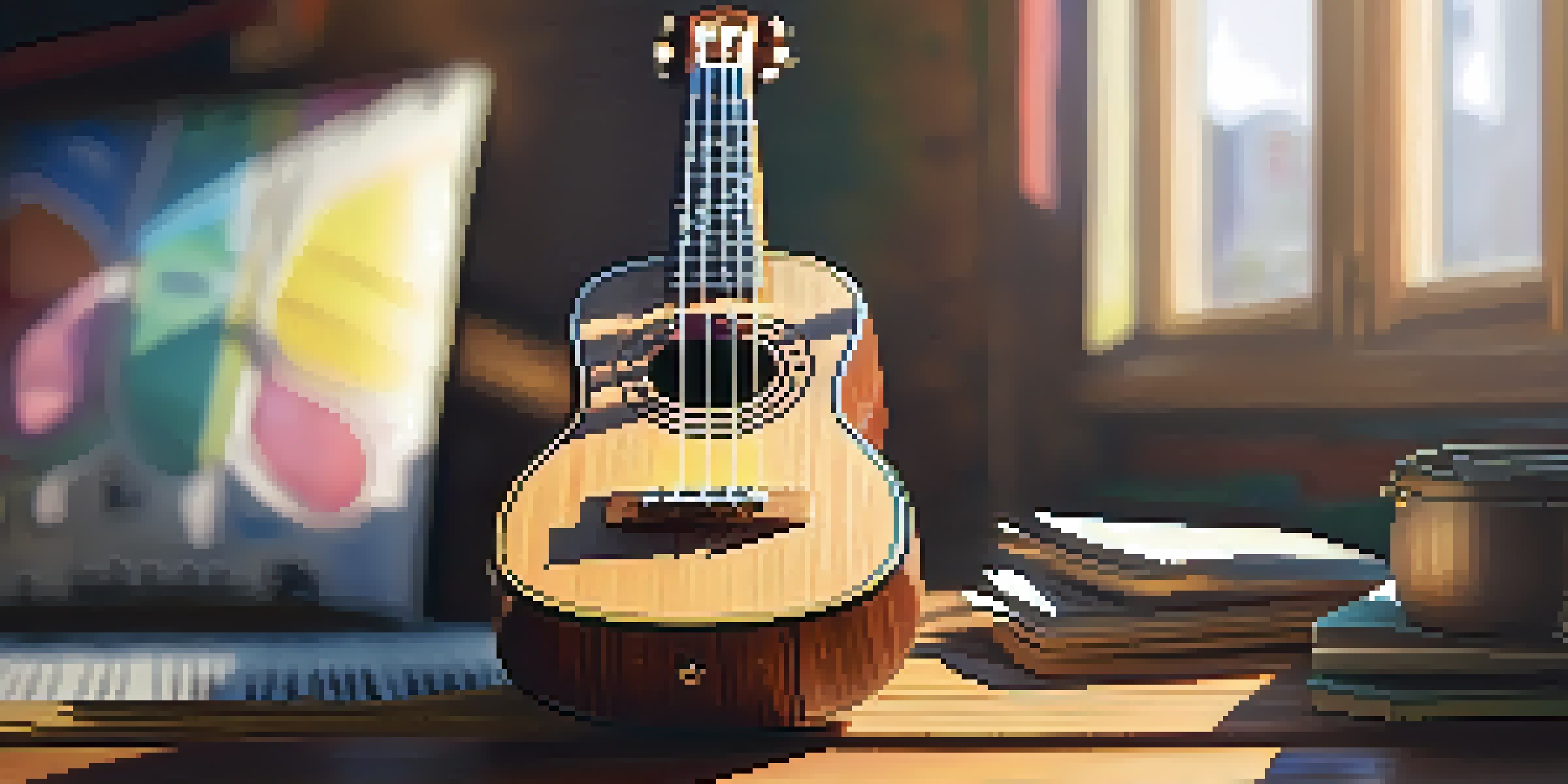Using Alternate Tunings: Innovative Approaches for Ukulele

Understanding Alternate Tunings for Ukulele
Alternate tunings are simply different ways to tune your ukulele strings compared to standard tuning. Standard tuning for a ukulele is G-C-E-A, which is great for many songs, but exploring alternate tunings can unlock a whole new world of sound. By changing the pitch of one or more strings, you can create unique chords and melodies that stand out in your playing.
Music can change the world because it can change people.
Think of alternate tunings like changing the recipe of your favorite dish. Just as a pinch of spice can transform a meal, a different tuning can alter the character of your music. For instance, tuning your ukulele to D-G-B-E (the same as the top four strings of a guitar) can make it easier to play guitar-like chords and voicings.
With countless alternate tunings available, it's essential to approach them with curiosity and experimentation. Don't be afraid to try out different tunings to see how they affect your style and sound. Each tuning can inspire new ideas and lead to exciting discoveries in your playing journey.
Popular Alternate Tunings for Ukulele
Some popular alternate tunings for ukulele include D-Tuning, C6 Tuning, and Low G Tuning. D-Tuning raises each string by a whole step, resulting in a bright, ringing sound that's perfect for upbeat tunes. C6 Tuning, often used in Hawaiian music, gives you a rich harmonic palette that's great for lush chords and melodies.

Low G Tuning involves tuning the G string down an octave, creating a deeper, warmer sound. This tuning is particularly favored by players looking to add more depth to their performances, allowing for a fuller sound that can complement singing or other instruments. It’s like switching from a standard piano to a grand piano—the richness is noticeable.
Explore Alternate Tunings for Variety
Experimenting with alternate tunings like D-Tuning and Low G Tuning can unlock unique sounds and enrich your musical expression.
Experimenting with these tunings can breathe new life into your playing. Even if you're comfortable with standard tuning, trying out these alternatives can help you discover fresh sounds and techniques that enhance your musical repertoire.
Techniques for Playing in Alternate Tunings
Once you've chosen an alternate tuning, it's essential to adapt your playing techniques accordingly. Finger positioning and chord shapes may change, so take the time to learn how to play familiar chords in your new tuning. This is similar to learning a new language; it may feel awkward at first, but with practice, it becomes second nature.
The only truth is music.
Another technique to consider is using a capo, which can help you play in different keys without changing your tuning. This allows you to maintain the unique sound of your alternate tuning while making it easier to play along with other musicians. Think of it as a tool that opens up new possibilities rather than a crutch.
Don't forget to explore fingerpicking and strumming patterns that complement your alternate tuning. Each tuning may inspire different rhythms or styles, so allow yourself to experiment. Just like a painter uses different brushes to create texture, you can use your skills in alternate tunings to develop a signature sound.
Incorporating Alternate Tunings in Songwriting
Using alternate tunings can significantly impact your songwriting process. When you change the tuning, you may find that new melodies and chord progressions emerge, which can lead to unexpected creative breakthroughs. This is akin to finding a hidden path in a familiar forest; it opens up new avenues that you might have otherwise missed.
For example, if you experiment with C6 Tuning, you might discover lush, dreamy chords that inspire a completely different vibe for your song. Many renowned songwriters have used unconventional tunings to craft iconic hits, proving that stepping outside the box can lead to remarkable results. Don't hesitate to let the tuning guide the mood and direction of your music.
Impact on Songwriting and Emotion
Changing tunings can inspire new melodies and evoke different emotional responses, enhancing your songwriting process.
Remember, songwriting is a journey of self-expression. By incorporating alternate tunings, you can add layers to your compositions that reflect your unique style and voice. Embrace the process, and allow these tunings to shape your musical identity.
Exploring the Emotional Impact of Tuning
The emotional response a listener feels can be deeply influenced by the tuning of an instrument. Alternate tunings can evoke a wide range of feelings, from joy to nostalgia, and everything in between. For instance, the bright sound of D-Tuning might lift spirits and energize a crowd, while Low G Tuning could create a more introspective and heartfelt atmosphere.
It's fascinating how different frequencies and tonalities can resonate with our emotions. Just like how a sad song can make you feel nostalgic, alternate tunings can shape the way your music is perceived. Consider how you want your audience to feel and choose your tunings accordingly.
As you explore these tunings, pay attention to the emotional responses they elicit in you and your listeners. This awareness can enhance your performance and songwriting, helping you create music that truly connects with people on a deeper level.
Tips for Practicing in Alternate Tunings
Practicing in alternate tunings can be both exciting and challenging. One effective tip is to start with familiar songs you already know in standard tuning and adapt them to your new tuning. This not only helps you ease into the alternate tuning but also reinforces your understanding of chord shapes and finger placements.
Additionally, consider keeping a practice journal. Documenting your progress, challenges, and breakthroughs can provide valuable insights and keep you motivated. It’s like having a roadmap for your musical journey, allowing you to reflect on how far you’ve come.
Practice Tips for Alternate Tunings
Start with familiar songs and keep a practice journal to ease into alternate tunings and track your progress effectively.
Lastly, don't rush the process. Allow yourself to enjoy the exploration and experimentation that comes with alternate tunings. Just as a gardener nurtures their plants over time, your skills will flourish with patience and consistent practice.
Resources for Learning Alternate Tunings
In today's digital age, there are countless resources available for learning alternate tunings on the ukulele. Websites, YouTube tutorials, and online forums can provide valuable insights, tips, and demonstrations that cater to various skill levels. Exploring these resources can significantly enhance your understanding and enjoyment of alternate tunings.
Books specifically focused on ukulele techniques and tunings can also offer structured learning paths. Many seasoned ukulele players and educators have compiled their knowledge into guides that can serve as excellent references. It's like having a mentor by your side, guiding you through the intricacies of alternate tunings.

Lastly, consider joining a ukulele community or group, whether online or in-person. Engaging with fellow ukulele enthusiasts allows you to share experiences, exchange ideas, and learn from one another. The camaraderie and support of a community can make your journey into alternate tunings both enjoyable and rewarding.